-
 Bitcoin
Bitcoin $84,648.7073
1.97% -
 Ethereum
Ethereum $1,881.9386
2.45% -
 Tether USDt
Tether USDt $0.9998
0.00% -
 XRP
XRP $2.1026
0.38% -
 BNB
BNB $601.4644
-1.14% -
 Solana
Solana $124.9250
-0.72% -
 USDC
USDC $1.0000
0.02% -
 Dogecoin
Dogecoin $0.1719
2.18% -
 Cardano
Cardano $0.6757
1.17% -
 TRON
TRON $0.2384
0.45% -
 Toncoin
Toncoin $4.0011
-2.68% -
 Chainlink
Chainlink $13.7441
1.08% -
 UNUS SED LEO
UNUS SED LEO $9.4106
2.26% -
 Stellar
Stellar $0.2689
1.56% -
 Avalanche
Avalanche $19.2640
1.44% -
 Sui
Sui $2.3638
1.05% -
 Shiba Inu
Shiba Inu $0.0...01238
-2.28% -
 Hedera
Hedera $0.1662
1.79% -
 Polkadot
Polkadot $4.1151
0.69% -
 Litecoin
Litecoin $83.1095
-0.72% -
 MANTRA
MANTRA $6.2091
-1.52% -
 Bitcoin Cash
Bitcoin Cash $305.6275
0.05% -
 Bitget Token
Bitget Token $4.6045
0.36% -
 Dai
Dai $0.9999
0.00% -
 Ethena USDe
Ethena USDe $0.9999
0.03% -
 Pi
Pi $0.6946
-3.71% -
 Hyperliquid
Hyperliquid $13.2719
-1.89% -
 Monero
Monero $218.1561
0.57% -
 Uniswap
Uniswap $6.1390
1.78% -
 Aptos
Aptos $5.3009
0.06%
What does blockchain mining mean? What is liquidity mining?
Blockchain mining validates transactions and adds them to the blockchain, while liquidity mining rewards users for providing liquidity to DeFi platforms, boosting trading efficiency.
Apr 01, 2025 at 12:07 am
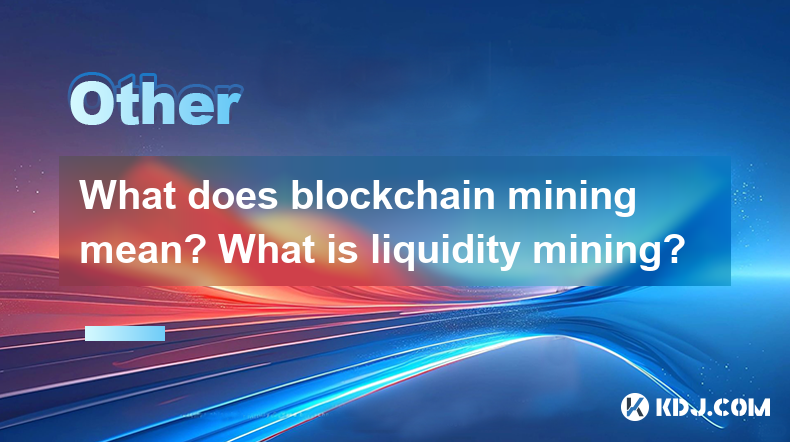
What is Blockchain Mining?
Blockchain mining is a critical process in the world of cryptocurrencies, particularly for networks like Bitcoin and Ethereum. It involves the use of computational power to solve complex mathematical problems, which in turn validates transactions and adds them to the blockchain. Miners are incentivized through rewards, typically in the form of the cryptocurrency they are mining. This process not only secures the network but also introduces new coins into circulation.
The concept of mining originated with Bitcoin, where miners compete to solve cryptographic puzzles. The first miner to solve the puzzle gets to add a new block of transactions to the blockchain and is rewarded with newly minted bitcoins. This process is known as Proof of Work (PoW). PoW requires significant energy and computational resources, leading to debates about its environmental impact.
How Does Blockchain Mining Work?
Blockchain mining works through a series of steps that ensure the integrity and security of the blockchain. Here's how it typically unfolds:
- Transaction Verification: Miners collect unverified transactions from the network's memory pool.
- Creating a Block: These transactions are grouped into a block.
- Solving the Puzzle: Miners compete to solve a cryptographic puzzle, which involves finding a hash that meets the network's difficulty criteria.
- Adding the Block: The first miner to solve the puzzle broadcasts the new block to the network. Other nodes verify the solution and, if valid, add the block to their copy of the blockchain.
- Reward Distribution: The successful miner receives a reward, usually in the form of cryptocurrency, and any transaction fees associated with the transactions in the block.
This process ensures that the blockchain remains decentralized and secure, as it would be extremely difficult for any single entity to control the majority of the network's mining power.
What is Liquidity Mining?
Liquidity mining is a relatively new concept in the cryptocurrency space, primarily associated with decentralized finance (DeFi) platforms. It involves users providing liquidity to a decentralized exchange (DEX) or liquidity pool and, in return, receiving rewards, often in the form of tokens. This process helps to ensure that there is enough liquidity on the platform for trading to occur smoothly.
Liquidity mining has become popular due to the rise of DeFi, which aims to create financial services without the need for traditional intermediaries. By incentivizing users to supply liquidity, these platforms can offer better trading conditions and attract more users. The rewards for liquidity providers can be substantial, but there are also risks involved, such as impermanent loss, which occurs when the price of the tokens in the pool changes.
How Does Liquidity Mining Work?
Liquidity mining operates through a series of steps that allow users to participate and earn rewards. Here's a breakdown of the process:
- Choosing a Platform: Users select a DeFi platform that offers liquidity mining opportunities.
- Providing Liquidity: Users deposit an equal value of two different tokens into a liquidity pool. For example, on Uniswap, a user might deposit ETH and DAI.
- Earning Rewards: In return for providing liquidity, users receive tokens from the platform, often referred to as governance tokens or liquidity provider (LP) tokens.
- Trading and Impermanent Loss: Other users can trade against the liquidity pool, and the liquidity providers earn a portion of the trading fees. However, if the price of the tokens in the pool changes significantly, providers may experience impermanent loss.
- Withdrawing Liquidity: Users can withdraw their liquidity at any time, receiving their share of the pool's tokens back, along with any earned rewards.
This process helps to maintain liquidity on decentralized platforms, making them more efficient and attractive to traders.
The Role of Miners in Blockchain Networks
Miners play a crucial role in maintaining the integrity and security of blockchain networks. Their primary function is to validate transactions and add them to the blockchain, ensuring that the network remains decentralized and resistant to fraud. Miners are rewarded for their efforts, which incentivizes them to continue participating in the network.
In Proof of Work systems like Bitcoin, miners compete to solve complex mathematical problems. The difficulty of these problems adjusts over time to ensure that new blocks are added at a consistent rate. This process is energy-intensive, leading to concerns about the environmental impact of mining. However, it also ensures that the network remains secure, as it would be extremely costly for any single entity to control the majority of the mining power.
The Impact of Liquidity Mining on DeFi
Liquidity mining has had a significant impact on the growth of decentralized finance (DeFi). By incentivizing users to provide liquidity, these platforms can offer better trading conditions and attract more users. This has led to a rapid expansion of the DeFi ecosystem, with billions of dollars locked in various protocols.
However, liquidity mining also comes with risks. Impermanent loss is a major concern for liquidity providers, as it can result in financial losses if the price of the tokens in the pool changes significantly. Additionally, the high rewards offered by some platforms can lead to unsustainable growth and potential market bubbles. Despite these risks, liquidity mining remains a popular way for users to participate in the DeFi ecosystem and earn rewards.
The Future of Blockchain and Liquidity Mining
The future of blockchain and liquidity mining is likely to be shaped by ongoing developments in technology and regulation. As blockchain technology continues to evolve, we may see more efficient consensus mechanisms that reduce the energy consumption associated with mining. For example, Proof of Stake (PoS) systems, which are used by networks like Ethereum 2.0, require validators to hold a certain amount of cryptocurrency rather than solving complex puzzles.
Liquidity mining is also likely to evolve, with platforms finding new ways to incentivize users and manage risks. As the DeFi ecosystem matures, we may see more stable and sustainable liquidity mining opportunities. Additionally, regulatory developments could impact the way liquidity mining operates, particularly in terms of how rewards are taxed and reported.
Common Questions About Blockchain and Liquidity Mining
Q: What is the main purpose of blockchain mining?
A: The main purpose of blockchain mining is to validate transactions and add them to the blockchain, ensuring the network's security and integrity. Miners are rewarded for their efforts, which incentivizes them to continue participating in the network.
Q: How do miners earn rewards in blockchain mining?
A: Miners earn rewards by being the first to solve a complex mathematical problem, which allows them to add a new block of transactions to the blockchain. The reward typically consists of newly minted cryptocurrency and any transaction fees associated with the transactions in the block.
Q: What is the difference between Proof of Work and Proof of Stake?
A: Proof of Work (PoW) requires miners to solve complex mathematical problems to validate transactions and add them to the blockchain. This process is energy-intensive. Proof of Stake (PoS) requires validators to hold a certain amount of cryptocurrency, and they are chosen to validate transactions based on the size of their stake. PoS is generally considered more energy-efficient.
Q: What is liquidity mining, and how does it work?
A: Liquidity mining involves users providing liquidity to a decentralized exchange or liquidity pool and receiving rewards in return. Users deposit an equal value of two different tokens into a pool, and in exchange, they earn tokens from the platform. This process helps to maintain liquidity on decentralized platforms, making them more efficient and attractive to traders.
Q: What is impermanent loss in liquidity mining?
A: Impermanent loss is a risk faced by liquidity providers in liquidity mining. It occurs when the price of the tokens in the liquidity pool changes significantly. If the price of one token increases relative to the other, the liquidity provider may end up with less value than if they had simply held the tokens. This loss is "impermanent" because it can be reversed if the prices return to their original levels.
Q: How can users mitigate the risks of liquidity mining?
A: Users can mitigate the risks of liquidity mining by carefully selecting platforms with strong fundamentals and sustainable reward structures. Diversifying their liquidity across multiple pools and tokens can also help to reduce the impact of impermanent loss. Additionally, users should stay informed about market conditions and be prepared to withdraw their liquidity if necessary.
Q: What is the environmental impact of blockchain mining?
A: Blockchain mining, particularly in Proof of Work systems like Bitcoin, has a significant environmental impact due to its high energy consumption. The process requires powerful computers that consume large amounts of electricity, leading to concerns about carbon emissions. Efforts are being made to develop more energy-efficient consensus mechanisms, such as Proof of Stake, to reduce the environmental footprint of blockchain networks.
Q: How does liquidity mining contribute to the growth of DeFi?
A: Liquidity mining contributes to the growth of DeFi by incentivizing users to provide liquidity to decentralized platforms. This helps to ensure that there is enough liquidity for trading to occur smoothly, making these platforms more attractive to users. The rewards offered by liquidity mining can attract more participants to the DeFi ecosystem, leading to increased activity and growth.
Q: What are the potential future developments in blockchain and liquidity mining?
A: Future developments in blockchain and liquidity mining may include more efficient consensus mechanisms, such as Proof of Stake, to reduce energy consumption. Liquidity mining platforms may also evolve to offer more sustainable reward structures and better risk management tools. Regulatory developments could also impact how these processes operate, particularly in terms of taxation and reporting requirements.
Disclaimer:info@kdj.com
The information provided is not trading advice. kdj.com does not assume any responsibility for any investments made based on the information provided in this article. Cryptocurrencies are highly volatile and it is highly recommended that you invest with caution after thorough research!
If you believe that the content used on this website infringes your copyright, please contact us immediately (info@kdj.com) and we will delete it promptly.
- Bittensor (TAO) Faces Bearish Pressure; Needs to Break Above $240 Resistance to Reverse Downward Trajectory
- 2025-04-02 12:35:12
- Cryptocurrency exchange Kraken lists JUST (JST), the governance token of the JUST ecosystem
- 2025-04-02 12:35:12
- BlockDAG (BDAG) Is Quickly Becoming a Serious Challenger to Other Layer 1 Chains
- 2025-04-02 12:30:12
- Fartcoin [FARTCOIN] was likely on its way to establishing an uptrend.
- 2025-04-02 12:30:12
- BlockDAG Accelerates Toward $600M Goal After Raising $5M in 48 Hours
- 2025-04-02 12:25:12
- Ethena (ENA) Token Unlock Scheduled for Tuesday, April 2.024-04-01
- 2025-04-02 12:25:12
Related knowledge
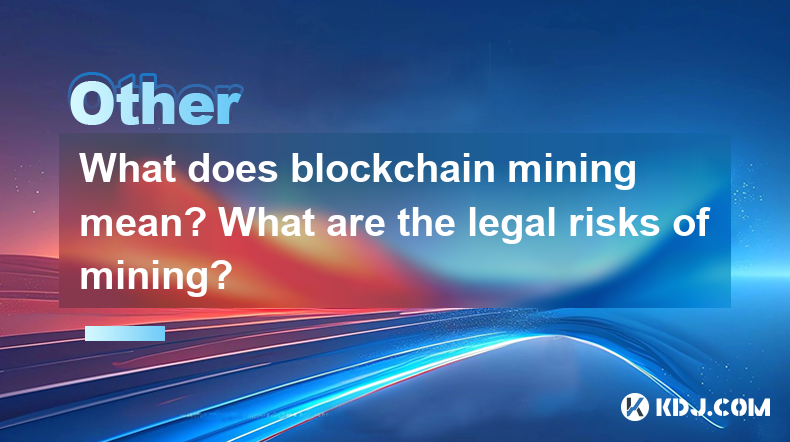
What does blockchain mining mean? What are the legal risks of mining?
Mar 31,2025 at 05:07pm
Blockchain mining is the process by which transactions are verified and added to the public ledger, known as the blockchain. Miners use powerful computers to solve complex mathematical problems, which, once solved, allow them to add a block of transactions to the blockchain. In return, miners are rewarded with cryptocurrency, typically Bitcoin. This pro...
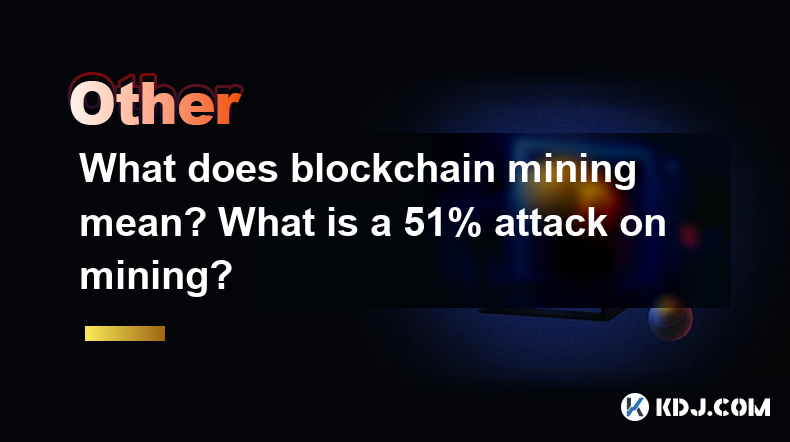
What does blockchain mining mean? What is a 51% attack on mining?
Apr 02,2025 at 03:28am
Blockchain mining is a critical process in the world of cryptocurrencies, particularly those that use proof-of-work (PoW) consensus mechanisms like Bitcoin. Mining involves using computational power to solve complex mathematical puzzles, which, when solved, validate and add new transactions to the blockchain. Miners are incentivized to participate throu...

What does blockchain mining mean? What is liquidity mining?
Apr 01,2025 at 12:07am
What is Blockchain Mining?Blockchain mining is a critical process in the world of cryptocurrencies, particularly for networks like Bitcoin and Ethereum. It involves the use of computational power to solve complex mathematical problems, which in turn validates transactions and adds them to the blockchain. Miners are incentivized through rewards, typicall...
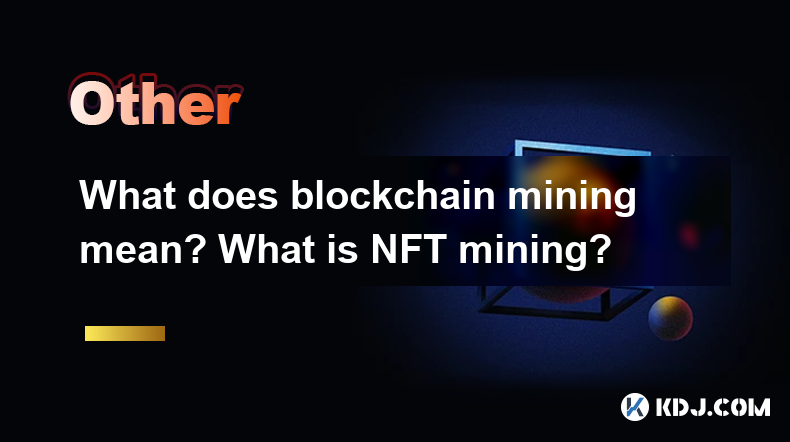
What does blockchain mining mean? What is NFT mining?
Mar 31,2025 at 04:07pm
Blockchain mining is a crucial process in the world of cryptocurrencies, particularly for networks like Bitcoin and Ethereum. It involves verifying transactions and adding them to the blockchain, a decentralized ledger. Miners use powerful computers to solve complex mathematical problems, which, when solved, allow them to add a block of transactions to ...

What does blockchain mining mean? What is the difference between cold wallets and hot wallets for mining?
Apr 01,2025 at 07:56am
Blockchain mining is a critical process in the world of cryptocurrencies. It involves verifying transactions and adding them to the blockchain, a decentralized ledger. Miners use powerful computers to solve complex mathematical problems, which, when solved, allow them to add a block of transactions to the blockchain. In return, miners are rewarded with ...
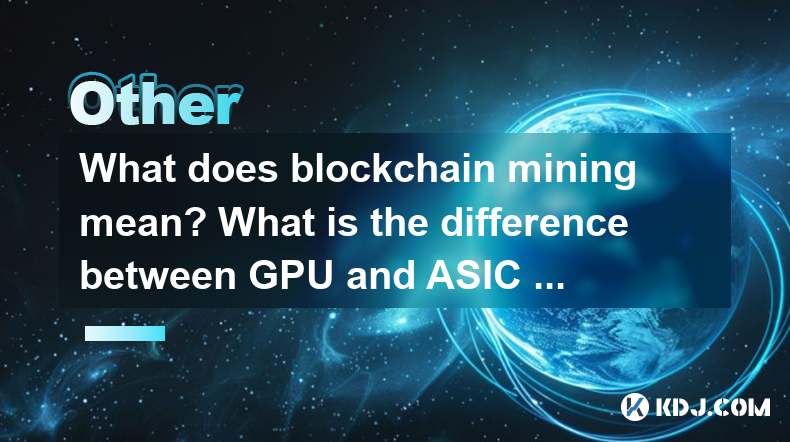
What does blockchain mining mean? What is the difference between GPU and ASIC mining?
Apr 01,2025 at 11:56am
Blockchain mining is a crucial process in the world of cryptocurrencies, particularly for networks like Bitcoin and Ethereum. At its core, mining involves solving complex mathematical problems to validate transactions and add them to the blockchain, a decentralized ledger. Miners compete to solve these problems, and the first to succeed is rewarded with...

What does blockchain mining mean? What are the legal risks of mining?
Mar 31,2025 at 05:07pm
Blockchain mining is the process by which transactions are verified and added to the public ledger, known as the blockchain. Miners use powerful computers to solve complex mathematical problems, which, once solved, allow them to add a block of transactions to the blockchain. In return, miners are rewarded with cryptocurrency, typically Bitcoin. This pro...

What does blockchain mining mean? What is a 51% attack on mining?
Apr 02,2025 at 03:28am
Blockchain mining is a critical process in the world of cryptocurrencies, particularly those that use proof-of-work (PoW) consensus mechanisms like Bitcoin. Mining involves using computational power to solve complex mathematical puzzles, which, when solved, validate and add new transactions to the blockchain. Miners are incentivized to participate throu...

What does blockchain mining mean? What is liquidity mining?
Apr 01,2025 at 12:07am
What is Blockchain Mining?Blockchain mining is a critical process in the world of cryptocurrencies, particularly for networks like Bitcoin and Ethereum. It involves the use of computational power to solve complex mathematical problems, which in turn validates transactions and adds them to the blockchain. Miners are incentivized through rewards, typicall...

What does blockchain mining mean? What is NFT mining?
Mar 31,2025 at 04:07pm
Blockchain mining is a crucial process in the world of cryptocurrencies, particularly for networks like Bitcoin and Ethereum. It involves verifying transactions and adding them to the blockchain, a decentralized ledger. Miners use powerful computers to solve complex mathematical problems, which, when solved, allow them to add a block of transactions to ...

What does blockchain mining mean? What is the difference between cold wallets and hot wallets for mining?
Apr 01,2025 at 07:56am
Blockchain mining is a critical process in the world of cryptocurrencies. It involves verifying transactions and adding them to the blockchain, a decentralized ledger. Miners use powerful computers to solve complex mathematical problems, which, when solved, allow them to add a block of transactions to the blockchain. In return, miners are rewarded with ...

What does blockchain mining mean? What is the difference between GPU and ASIC mining?
Apr 01,2025 at 11:56am
Blockchain mining is a crucial process in the world of cryptocurrencies, particularly for networks like Bitcoin and Ethereum. At its core, mining involves solving complex mathematical problems to validate transactions and add them to the blockchain, a decentralized ledger. Miners compete to solve these problems, and the first to succeed is rewarded with...
See all articles

























































































